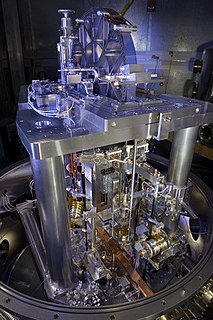
The kilogram is the SI base unit of mass, having the unit symbol kg. It is a widely used measure in science, engineering and commerce worldwide, and is often simply called a kilo colloquially. It means 'one thousand grams'.
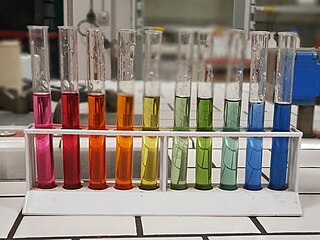
In chemistry, pH, historically denoting "potential of hydrogen", is a scale used to specify the acidity or basicity of an aqueous solution. Acidic solutions are measured to have lower pH values than basic or alkaline solutions.

Salinity is the saltiness or amount of salt dissolved in a body of water, called saline water. It is usually measured in g/L or g/kg.

The metric system is a system of measurement that succeeded the decimalised system based on the metre that had been introduced in France in the 1790s. The historical development of these systems culminated in the definition of the International System of Units (SI) in the mid-20th century, under the oversight of an international standards body. Adopting the metric system is known as metrication.

The electrical resistance of an object is a measure of its opposition to the flow of electric current. Its reciprocal quantity is electrical conductance, measuring the ease with which an electric current passes. Electrical resistance shares some conceptual parallels with mechanical friction. The SI unit of electrical resistance is the ohm, while electrical conductance is measured in siemens (S).
Electrical resistivity is a fundamental property of a material that measures how strongly it resists electric current. A low resistivity indicates a material that readily allows electric current. Resistivity is commonly represented by the Greek letter ρ (rho). The SI unit of electrical resistivity is the ohm-meter (Ω⋅m). For example, if a 1 m3 solid cube of material has sheet contacts on two opposite faces, and the resistance between these contacts is 1 Ω, then the resistivity of the material is 1 Ω⋅m.
CF, Cf, cf and similar may refer to:
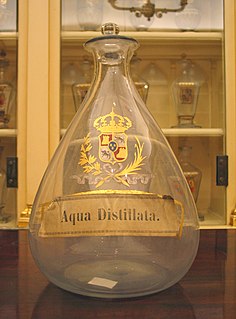
Purified water is water that has been mechanically filtered or processed to remove impurities and make it suitable for use. Distilled water was, formerly, the most common form of purified water, but, in recent years, water is more frequently purified by other processes including capacitive deionization, reverse osmosis, carbon filtering, microfiltration, ultrafiltration, ultraviolet oxidation, or electrodeionization. Combinations of a number of these processes have come into use to produce ultrapure water of such high purity that its trace contaminants are measured in parts per billion (ppb) or parts per trillion (ppt).
Degrees Brix is the sugar content of an aqueous solution. One degree Brix is 1 gram of sucrose in 100 grams of solution and represents the strength of the solution as percentage by mass. If the solution contains dissolved solids other than pure sucrose, then the °Bx only approximates the dissolved solid content. For example, when one adds equal amounts of salt and sugar to equal amounts of water, the degrees of refraction (BRIX) of the salt solution rises faster than the sugar solution. The °Bx is traditionally used in the wine, sugar, carbonated beverage, fruit juice, fresh produce, maple syrup and honey industries.

A salinometer is a device designed to measure the salinity, or dissolved salt content, of a solution.
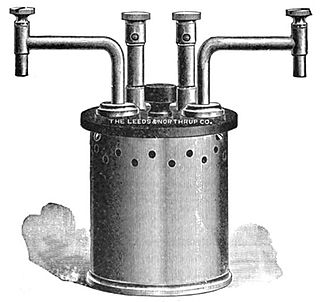
The ohm is the SI derived unit of electrical resistance, named after German physicist Georg Ohm. Various empirically derived standard units for electrical resistance were developed in connection with early telegraphy practice, and the British Association for the Advancement of Science proposed a unit derived from existing units of mass, length and time, and of a convenient scale for practical work as early as 1861. As of 2020, the definition of the ohm is expressed in terms of the quantum Hall effect.
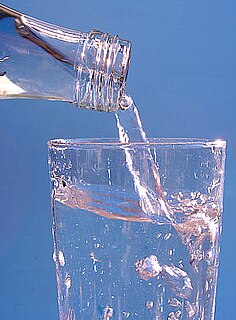
Total dissolved solids (TDS) is a measure of the dissolved combined content of all inorganic and organic substances present in a liquid in molecular, ionized, or micro-granular suspended form. TDS concentrations are often reported in parts per million (ppm). Water TDS concentrations can be determined using a digital meter.
In petrophysics, Archie's law relates the in-situ electrical conductivity (C) of a porous rock to its porosity and fluid saturation of the pores:

Deep water culture (DWC) is a hydroponic method of plant production by means of suspending the plant roots in a solution of nutrient-rich, oxygenated water. Also known as deep flow technique (DFT), floating raft technology (FRT), or raceway, this method uses a rectangular tank less than one foot deep filled with a nutrient-rich solution with plants floating in Styrofoam boards on top. This method of floating the boards on the nutrient solution creates a near friction-less conveyor belt of floating rafts. DWC, along with nutrient film technique (NFT), and aggregate culture, is considered to be one of the most common hydroponic systems used today. Typically, DWC is used to grow short-term, non-fruiting crops such as leafy greens and herbs. The large volume of water helps mitigate rapid changes in temperature, pH, electrical conductivity (EC), and nutrient solution composition.
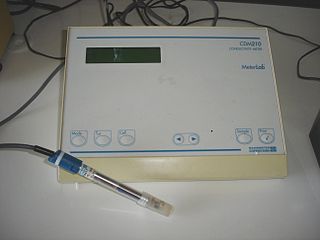
An electrical conductivity meter measures the electrical conductivity in a solution. It has multiple applications in research and engineering, with common usage in hydroponics, aquaculture, aquaponics, and freshwater systems to monitor the amount of nutrients, salts or impurities in the water.

Conductivity of an electrolyte solution is a measure of its ability to conduct electricity. The SI unit of conductivity is Siemens per meter (S/m).
Ultrapure water (UPW), high-purity water or highly purified water (HPW) is water that has been purified to uncommonly stringent specifications. Ultrapure water is a term commonly used in manufacturing to emphasize the fact that the water is treated to the highest levels of purity for all contaminant types, including: organic and inorganic compounds; dissolved and particulate matter; volatile and non-volatile; reactive, and inert; hydrophilic and hydrophobic; and dissolved gases.
The siemens is the SI derived unit of electric conductance, electric susceptance, and electric admittance. Conductance, susceptance, and admittance are the reciprocals of resistance, reactance, and impedance respectively; hence one siemens is redundantly equal to the reciprocal of one ohm and is also referred to as the mho. The 14th General Conference on Weights and Measures approved the addition of the siemens as a derived unit in 1971.

Fester Hollow is a tributary of West Branch Briar Creek in Columbia County, Pennsylvania, in the United States. It is 4.54 miles (7.31 km) long.












